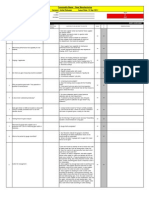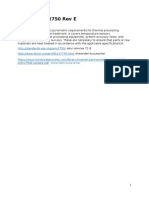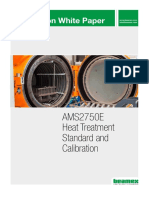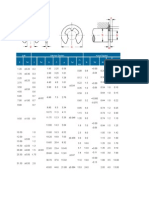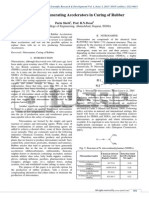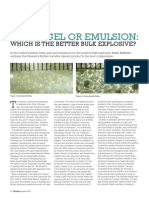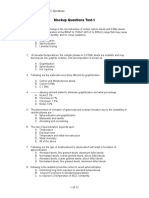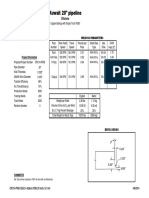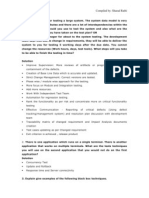CP Training On Pyrometrics
CP Training On Pyrometrics
Uploaded by
alien686Copyright:
Available Formats
CP Training On Pyrometrics
CP Training On Pyrometrics
Uploaded by
alien686Original Description:
Original Title
Copyright
Available Formats
Share this document
Did you find this document useful?
Is this content inappropriate?
Copyright:
Available Formats
CP Training On Pyrometrics
CP Training On Pyrometrics
Uploaded by
alien686Copyright:
Available Formats
Pyrometry
Bob Faticanti
Sr. Manager Supplier Development Eng. /
Textron Defense Systems
Chemical Processing
October 21, 2012
Objectives of Training
1. Improve Understanding of Pyrometry
Basics
2. Improve Understanding of AC7108
sections 5.4 and 5.5
3. Communicate AMS 2750 Rev. E
4. Answer any questions
IMPROVE UNDERSTANDING OF PYROMETRY
BASICS
Objective #1
AC7108 section 5.4
Only required to verify the questions in this
section.
However, AMS 2750 is considered the
baseline requirement
Customers may have higher requirements
High Level
Does it look like they know what they are
doing?
Check the procedure, SAT and TUS
reports
Considerations
Does the Supplier also do Heat Treating?
Are they Nadcap accredited for Heat Treating?
Are their HT pyrometry systems also over the CP Thermal
Processes?
Does the Supplier do the pyrometry themselves?
Does the Supplier outsource pyrometry?
Procedures
Even if Outsourced
Replacement of control sensors (typically annually per 3.4.3.4)
SAT procedure
Frequency
Correction factors
TUS procedure
Define Work Zone Size affects # of sensors and locations Corners of TUS
sensors = Boundary of where product can be placed Needs communicated to
shop
Survey temperatures and qualified operating range
Quality needs to review
Any maintenance that could affect SAT
Any furnace modifications (defined 3.5.3) that could affect TUS
Address any out of tolerance needs evaluated per material review procedures
Quality needs to review and approve Instrument Calibration, SAT Report, and
TUS Reports
AMS 2750 Rev D
AMS 2750 Rev D
Lets Start with
Thermocouples,
Controllers and Recording
Instrumentation
Thermocouples (T/C)
Sensors have errors. This needs accounted for or the SAT/TUS
data is wrong
Does the Certificate of Compliance for the T/C State the
Correction Factor or Deviation?
NOTE: They need to reverse the sign if it lists a Deviation
Average Front to Back of the wire at a given temperature
Always add the Correction Factor algebraically
e.g. on the following example. If the Temperature measured shows 1510F
then the true value is 1510 + (-1.5) = 1508.5F.
T/C Correction Factor Cont.
Was the T/C Correction Factor Determined
correctly?
Do Not Extrapolate Beyond Calibration Range
One can use various methods but be consistent
Use the closest value
Use correction factor that is the highest
Use the correction factor that is the lowest
Linearly Interpolate between Temperatures
Other items on Site
Check if the Supplier has the items
required to be on site per 3.5.21.2
Tested within oper. range
System Accuracy Testing
System Accuracy Test tests the
accuracy of the control T/C
What does the SAT need?
Weekly System Accuracy Test (S.A.T.) Results
Week:
3/11-3/17
Year:
2012
Test Instrument
Test Sensor
Identification/Information Controller
Test
Sensor Disposition
Furnace Initials Date Time
Handhel
d ID# S/N
Due Date
for
Handheld
Calibration
E
Handheld
Correction
Factor
Type
(Prob
e or
T/C) S/N or ID
Calibration
Cert./Spool
#
D
Correction
Factor
Due Date for
Probe
Calibration
Temp.
Setpoint Offset
A
Temp
Actual
B
Temp As
Read
C
(B+D+E)
Temp.
Correcte
d
F
SAT
Differenc
e (C-A)
Accept
/ Reject
Quality
Initials
A Z1 VD 3/14/12 4:17 AM 09-170 5/9/12 -1 P 15222 15222 0.65 5/13/2012 980 0 980 976.6 976.25 -3.75
A Z2 VD 3/14/12 4:17 AM 09-170 5/9/12 -1 P 15219 15219 0.35 5/13/2012 980 0 980 977.1 976.45 -3.55
B Sol VD 3/13/12 2:34 PM 09-170 5/9/12 -1 P 15226 15226 1.08 5/6/2012 1000 0 1000 998.1 998.18 -1.82
C Sol VD 3/15/12 12:36 PM 09-170 5/9/12 -1 P 15176 15176 2.5 4/30/2012 1000 0 1000 1000.1 1001.6 1.6
D Sol 09-170 P 0 0
E Sol VD 3/14/12 11:04 AM 09-170 5/9/12 -1 P 15233 15233 1.25 4/28/2012 980 0 980 975.6 975.85 -4.15
0 0
A age VD 3/14/12 8:19 AM 09-170 5/9/12 -0.8 P 15227 15227 0.2 4/30/2012 370 5 365 365.6 365 0
B age VD 3/15/12 11:00 AM 09-170 5/9/12 -0.9 P 15218 15218 -0.1 4/30/2012 475 -5 480 474.4 473.4 -6.6
C age DOWN 09-170 P 0 0
D age VD 3/15/12 4:30 AM 09-170 5/9/12 -0.8 P 15210 15210 2.01 4/17/2012 370 -5 375 373 374.21 -0.79
Temperature Uniformity Survey
Temperature Uniformity Survey tests the
variation in temperature within a defined space.
Example TUS rack:
WORK ZONE
AMS 2750 Rev D
390 Cubic Ft. Furnace
What Does TUS Report need?
Accepted and signed
by QC.
TUS Checklist
Does the TUS show high & low T/C results
Did the TUS run for 30 minutes after all T/Cs are
stabilized? Does it show data before they are stabilized?
Was the correct number of T/Cs used? (see table 11 for
required #)
Is there a diagram of the locations? (see 3.5.13.2 for
required locations)
Did they use a rack? If so is the load condition
maintained per 3.5.10
What is the operating range of the oven/furnace? Are
the high and low surveyed at least once per year?
Each Oven/Furnace must be identified with the operating
Temperature Range: ex. 350 1000 F
Passing SAT/TUS
Checklist requires Class 5 unless more stringent
is specified by the customer.
Specified by customer by detailing a
temperature range, e.g. 550 +/- 15 makes it
class 3. See 3.3.1 Figure A.
SAT
To pass = +/-5 F unless more stringent class is
specified by the customer
TUS
To pass = +/-25F from set point unless more stringent
is specified by customer.
AMS 2750 D Para 3.3.1
Figure A
Furnace Class - Temperature Uniformity Range (Degrees F) - Temperature Uniformity Range (Degrees C)
1 +/- 5 F
+/-3 C
2 +/- 10 F
+/-6 C
3 +/- 15 F
+/-8 C
4 +/- 20 F
+/- 10 C
5 +/- 25 F
+/- 14 C
6 +/- 50 F
+/- 28 C
Failing a TUS/SAT
Did the TUS/SAT report state fail?
Did any fail but not state fail?
Did the Supplier take action? e.g. MRB for
all product since last good test
If the external report stated failed was the
supplier notified by the pyrometry vendor?
IMPROVE UNDERSTANDING OF AC7108
SECTIONS 5.4 AND 5.5
Objective #2
5.5 Misc. equipment below 250F or
otherwise not controlled by 5.4
The key point is to avoid overheating parts which could be damaging or to
ensure any customer requirements are met.
5.5.1
Are there controllers? Are they calibrated? Check records, check
calibration recall system, check sticker on the controllers
5.5.2
This is basically asking for a TUS light. They may not be following all of
pyrometry rules but need to define the space for the product and
testing sensors. Are there procedures? Is a frequency defined? Are
max temperatures checked? Are min temps checked if applicable? Is
the work zone defined? Is it defined how test is done?
TBD
Once AC7108 Rev F is finalized, it needs
to be reviewed to determine what, if any
changes need to be emphasized to CP
auditors.
AMS 2750 Rev E
AMS 2750D went into effect in 2005
Substantial overhaul of Rev. C
Rev E went into effect July, 2012
~50 editorial changes or changes to clarify rather
than alter the technical requirements.
~25 changes noted as changes to technical
requirements
Provide a handout summarizing changes.
Highlight those applicable to CP.
TBD
Now that AMS 2750 Rev E is finalized, it
needs to be reviewed to determine what, if
any changes need to be communicated to
CP auditors to look for.
Examples: Are Suppliers aware revision
has changed? Do they have a copy of it?
Are TUS/SAT reports from a vendor to the
latest revision?
Questions
You might also like
- AC7108 Rev G Chemical ProcessingDocument77 pagesAC7108 Rev G Chemical ProcessingDimitris GrimanelisNo ratings yet
- SAP MM Configuration ChecklistDocument4 pagesSAP MM Configuration ChecklistPrashant KumarNo ratings yet
- Amrit Cement Industrial ReportDocument38 pagesAmrit Cement Industrial Reportmanish mohan upadhyayNo ratings yet
- Reductor SHB50-FDocument28 pagesReductor SHB50-FJaime Casas-corderoNo ratings yet
- Astm B117 03Document10 pagesAstm B117 03EMRENo ratings yet
- Pyrometry Guide 20 Nov 12Document51 pagesPyrometry Guide 20 Nov 12Sinan Yıldız83% (6)
- NADCAP - Pyrometry Guide 20 Nov 12Document51 pagesNADCAP - Pyrometry Guide 20 Nov 12Renato Fernandes100% (1)
- Mil-Dtl 16232Document13 pagesMil-Dtl 16232Hasan Raza100% (1)
- Diagrama Elecrico HUSKY 400TON 3745428Document57 pagesDiagrama Elecrico HUSKY 400TON 3745428Roberto VillegasNo ratings yet
- AC7102.8 Rev NADocument8 pagesAC7102.8 Rev NASatyendra PandeyNo ratings yet
- Drop TestDocument3 pagesDrop TestFairna Junicia SumampouwNo ratings yet
- Key Changes AMS2750 Revision F July 2020Document37 pagesKey Changes AMS2750 Revision F July 2020JACNo ratings yet
- 9101f Form1 UlDocument9 pages9101f Form1 UlRam Kumar100% (1)
- AMS 2750E System Accuracy Testing & Temperature Uniformity SurveysDocument2 pagesAMS 2750E System Accuracy Testing & Temperature Uniformity SurveysMickloSoberanNo ratings yet
- Astm e 1251-2011Document10 pagesAstm e 1251-2011ERDA TPI REPORTNo ratings yet
- Salt Spray Cabinet BGD 800SDocument5 pagesSalt Spray Cabinet BGD 800SRoyNo ratings yet
- Engineering Standards: Material Specification Metals GM6435MDocument6 pagesEngineering Standards: Material Specification Metals GM6435MAkmal NizametdinovNo ratings yet
- Thermocouple Accuracy and Adherence To Critical StandardsDocument13 pagesThermocouple Accuracy and Adherence To Critical Standardsdnguyen_63564No ratings yet
- Roush Paint Appearance Standard AS 100 1 PDFDocument6 pagesRoush Paint Appearance Standard AS 100 1 PDFBESNo ratings yet
- HT Pyometry Guide Updated 5jan2017Document54 pagesHT Pyometry Guide Updated 5jan2017Anil BabuNo ratings yet
- Iso 4540 1980 FR en PDFDocument8 pagesIso 4540 1980 FR en PDFTSA Bekasi Raya100% (1)
- Rma New Blank PC ReturnDocument1 pageRma New Blank PC Returnarshadsamudh3100% (1)
- Temperature Uniformity Surveying For Vacuum Furnaces Optimizing Procedure ForDocument16 pagesTemperature Uniformity Surveying For Vacuum Furnaces Optimizing Procedure Foranilbabu4No ratings yet
- Ac7109 Rev eDocument11 pagesAc7109 Rev eRajib Barua100% (1)
- Vishal Nadcap Process - JulioDocument33 pagesVishal Nadcap Process - JulioEr. Ramji TripathiNo ratings yet
- PRI & Nadcap Overview: Updated 15-May 2014 For ASTM E-01Document35 pagesPRI & Nadcap Overview: Updated 15-May 2014 For ASTM E-01amirkhakzad498100% (1)
- Furnace Specification - AMS 2750F - CQI-9Document2 pagesFurnace Specification - AMS 2750F - CQI-9Jorge Ferreira100% (1)
- GM 1927-16a PWT Gear Commodity AuditDocument5 pagesGM 1927-16a PWT Gear Commodity AuditSergio BoillosNo ratings yet
- 272Document14 pages272Ioana AlexandraNo ratings yet
- MIL-STD-810G Salt Spray Portion OnlyDocument10 pagesMIL-STD-810G Salt Spray Portion Onlyeklock01No ratings yet
- Send/Propose & General Releasing Tips: Version: IMDS Release 10.0Document39 pagesSend/Propose & General Releasing Tips: Version: IMDS Release 10.0Vanessa Alves Moreira100% (1)
- Specular Gloss: Standard Test Method ForDocument5 pagesSpecular Gloss: Standard Test Method ForSgjsevenpNo ratings yet
- List of Questions To Ask Your AS9100 Consultant ENDocument2 pagesList of Questions To Ask Your AS9100 Consultant ENNarasimharaghavanPuliyurKrishnaswamyNo ratings yet
- AMS 2750 Rev EDocument17 pagesAMS 2750 Rev EBurcin BogaNo ratings yet
- Beamex White Paper - AMS2750E Heat Treatment ENGDocument7 pagesBeamex White Paper - AMS2750E Heat Treatment ENGrobertNo ratings yet
- AMS 2750 e EnglischDocument3 pagesAMS 2750 e EnglischQualidadeTFNo ratings yet
- TAPPI/ANSI T 437 Om-12: 1. ScopeDocument5 pagesTAPPI/ANSI T 437 Om-12: 1. ScopeSteffany Silva100% (1)
- Soldering IronDocument12 pagesSoldering IronfjsabNo ratings yet
- ASTM E505 - 01 (2011) Standard Reference Radiographs For Inspection of Aluminum and Magnesium Die CastingsDocument3 pagesASTM E505 - 01 (2011) Standard Reference Radiographs For Inspection of Aluminum and Magnesium Die CastingschinwaihoongNo ratings yet
- Powder Coat Performance Spec WSS M70J5 C1Document9 pagesPowder Coat Performance Spec WSS M70J5 C1Michal BílekNo ratings yet
- Operating Salt Spray (Fog) Apparatus: Standard Practice ForDocument11 pagesOperating Salt Spray (Fog) Apparatus: Standard Practice ForFelipeMoriNo ratings yet
- Is 15421-1 (Iso 13565-1)Document9 pagesIs 15421-1 (Iso 13565-1)SvapneshNo ratings yet
- Introduction To DSCDocument144 pagesIntroduction To DSCsecateNo ratings yet
- 1.heat Treatment - Avsp 01Document10 pages1.heat Treatment - Avsp 01Siva100% (1)
- Certified Reference Material BCR - 033 Certificate of AnalysisDocument3 pagesCertified Reference Material BCR - 033 Certificate of Analysisandri gerhanaNo ratings yet
- Mil DTLDocument2 pagesMil DTLNataša VavraNo ratings yet
- Astm b557 15 PDFDocument16 pagesAstm b557 15 PDFcra29No ratings yet
- Agilent Calibration FrequencyDocument6 pagesAgilent Calibration Frequencyzilangamba_s4535No ratings yet
- Ilac P9 01 2024Document14 pagesIlac P9 01 2024DIANA LORENA QUICENONo ratings yet
- Imds Recommendation 001 Annex IDocument33 pagesImds Recommendation 001 Annex IAnjali DeshpandeNo ratings yet
- Vacuum Brazing: Dawei Induction Heating Machine Co., LTDDocument9 pagesVacuum Brazing: Dawei Induction Heating Machine Co., LTDsajitha p sNo ratings yet
- ASQ MSA An Alternative Method For Estimating Percentage Tolerance 20120418Document78 pagesASQ MSA An Alternative Method For Estimating Percentage Tolerance 20120418solmaz MOVAFAGHINo ratings yet
- Uncertainty of Measurements Part I Compliance Testing PDFDocument8 pagesUncertainty of Measurements Part I Compliance Testing PDFParkhomyukNo ratings yet
- Passivation Criteria For NadCAPDocument49 pagesPassivation Criteria For NadCAPSounak BanerjeeNo ratings yet
- Din 6799Document1 pageDin 6799orkunugurNo ratings yet
- Nitrosamine Generating Accelerators in Curing of RubberDocument3 pagesNitrosamine Generating Accelerators in Curing of RubberkarlosmpNo ratings yet
- Recent Changes in Aerospace StandardsDocument16 pagesRecent Changes in Aerospace Standardschitti409100% (1)
- Calibration of Non Automatic Instruments OIML BULLETIN VOLUME XLIVDocument15 pagesCalibration of Non Automatic Instruments OIML BULLETIN VOLUME XLIVLeonardo G. Pereira NetoNo ratings yet
- Nitriding Nitrocarburizing Complying To Automotive Aerospace SpecsDocument45 pagesNitriding Nitrocarburizing Complying To Automotive Aerospace SpecsCristofer CrisNo ratings yet
- Why Intensity Isn't Dependent On Exposure Time: Lessons in Intensity and CoverageDocument1 pageWhy Intensity Isn't Dependent On Exposure Time: Lessons in Intensity and CoverageUmit Aytar100% (1)
- Sop SRTC Cal Sop T 05 (Temp. Gauge) - LabDocument3 pagesSop SRTC Cal Sop T 05 (Temp. Gauge) - Labsureshcal131No ratings yet
- Basics of Pyrometry, Industry Specifications and Temperature Uniformity SurveysDocument5 pagesBasics of Pyrometry, Industry Specifications and Temperature Uniformity SurveysTanzil ZaidiNo ratings yet
- AC7102.8 Rev B - CLEANDocument24 pagesAC7102.8 Rev B - CLEANradimkov75No ratings yet
- Pyrometry Guide 20 Nov 12Document51 pagesPyrometry Guide 20 Nov 12X800XLNo ratings yet
- Effective Corrective ActionsDocument40 pagesEffective Corrective Actionsalien686100% (1)
- Commercial Dedication A Manufacturer's PerspectiveDocument8 pagesCommercial Dedication A Manufacturer's Perspectivealien686No ratings yet
- Commercial Grade DedicationDocument14 pagesCommercial Grade Dedicationalien686100% (1)
- Introduction To Welding TechnologyDocument53 pagesIntroduction To Welding Technologyalien686No ratings yet
- Magnetic Properties of Stainless SteelDocument8 pagesMagnetic Properties of Stainless Steelalien686No ratings yet
- SSPC PA2 PresentationDocument8 pagesSSPC PA2 PresentationAnbalagan RavichandranNo ratings yet
- Commercial Grade Dedication GuidanceDocument64 pagesCommercial Grade Dedication Guidancealien686No ratings yet
- Mil STD 410eDocument20 pagesMil STD 410ealien686No ratings yet
- Watergel or Emulsions Which Is The Better Bulk Explosive?Document4 pagesWatergel or Emulsions Which Is The Better Bulk Explosive?Brent BuffhamNo ratings yet
- Plastering: Indian Standard (BIS Codes) Specifications UsedDocument4 pagesPlastering: Indian Standard (BIS Codes) Specifications UsedMĄnjů Đ ĞNo ratings yet
- CS300.1 CS60.4 CS60.2: The Official Brand of Live MusicDocument8 pagesCS300.1 CS60.4 CS60.2: The Official Brand of Live MusicLuis RodriguezNo ratings yet
- Week 10 Architectectural EngineeringDocument30 pagesWeek 10 Architectectural EngineeringRahim AssaniNo ratings yet
- Ir Controlled RGB BulbDocument2 pagesIr Controlled RGB BulbNarmeti LokeshNo ratings yet
- Jet-Lube FMG Grease 2Document1 pageJet-Lube FMG Grease 2Don HowardNo ratings yet
- TS 3.02.01 RES I2Document12 pagesTS 3.02.01 RES I2Madhusudhan SrinivasanNo ratings yet
- DR Fixit Powercrete 77 1Document4 pagesDR Fixit Powercrete 77 1Karthikeyan PanchatcharamNo ratings yet
- API-571 Mockup Test-01-QuestionsDocument13 pagesAPI-571 Mockup Test-01-QuestionsMonday100% (1)
- Kuwait 20" Pipeline: OilstoneDocument3 pagesKuwait 20" Pipeline: OilstoneShravan ThangallapalliNo ratings yet
- SDS - Chemrock 913Document1 pageSDS - Chemrock 913mangengueyNo ratings yet
- Ethylene Oxide Sterilization PDFDocument2 pagesEthylene Oxide Sterilization PDFRobertNo ratings yet
- Coal Properties Vs Boiler Performance, Boiler and APH PErformance and Heat Rate V0.1Document142 pagesCoal Properties Vs Boiler Performance, Boiler and APH PErformance and Heat Rate V0.1soumitraban100% (1)
- The Production of Indigo Dye From Plants (PDFDrive)Document47 pagesThe Production of Indigo Dye From Plants (PDFDrive)Dewan Ajuad Hossain RifatNo ratings yet
- Haz Metal Do Galt AsDocument58 pagesHaz Metal Do Galt AsarchmenNo ratings yet
- CSTE Test Cases Compiled By: Sharad RathiDocument4 pagesCSTE Test Cases Compiled By: Sharad Rathidhanabhakkiyam100% (1)
- Design Problem - Marble Sorter: Project 3.3.1 - Vex and RobotcDocument17 pagesDesign Problem - Marble Sorter: Project 3.3.1 - Vex and Robotcapi-318147212No ratings yet
- LN2 Specification Sheet PDFDocument3 pagesLN2 Specification Sheet PDFMangal SinghNo ratings yet
- Clarification-1 Anwar IspatDocument42 pagesClarification-1 Anwar IspatPranoy BaruaNo ratings yet
- Overview of Development Geology: Parke A. DickeyDocument1 pageOverview of Development Geology: Parke A. DickeyalmayNo ratings yet
- ABB Lightning ArrestersDocument4 pagesABB Lightning ArrestersPrashanth ChandrashekarNo ratings yet
- CP770 Cotton Picker S N 248999 Replacement Parts GuideDocument6 pagesCP770 Cotton Picker S N 248999 Replacement Parts Guideeduardo SeverinoNo ratings yet
- Q-0721-0183 R.1 Daikin (Based On Boq)Document3 pagesQ-0721-0183 R.1 Daikin (Based On Boq)Danis Eko TanowoNo ratings yet
- NSCR GCR N01 Aplstn DRC ST 000055Document3 pagesNSCR GCR N01 Aplstn DRC ST 000055AdrianNodaloNo ratings yet
- Bresenham Line Drawing Algorithm, Circle Drawing & Polygon FillingDocument50 pagesBresenham Line Drawing Algorithm, Circle Drawing & Polygon FillingMidhun ChakravarthyNo ratings yet
- 19.DG Inspection ChecklistDocument1 page19.DG Inspection ChecklistP.M.K anthNo ratings yet



























